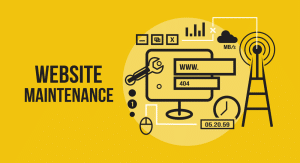Top Tips for Regular Website Maintenance and Updates
To guarantee that your website is safe, functions properly, and offers a satisfying user experience, regular website maintenance is essential. Inadequate website upkeep can result in obsolete material, broken links, slow load times, and security flaws that may turn off visitors. We’ll go over the crucial actions you should take in this post to maintain the best possible website, which will help you remain competitive and maintain audience interest.

Why Regular Website Maintenance Matters
Updating content is only one aspect of website maintenance; another is making sure everything functions properly and securely. You will gain the following advantages by making time for routine maintenance:
Enhanced Security: Malware and security breaches are prevented by routine maintenance.
Better Performance: A well-kept website provides a smooth user experience and loads rapidly.
Improved SEO Rankings: Up-to-date and functional websites are given preference by search engines, which raises their rankings.
Improved User Engagement: Relevant, up-to-date material keeps consumers engaged and motivates them to come back.
Essential Tips for Effective Website Maintenance
These are the best pointers to help you keep your website up to date and operating at its best.
1. Conduct Regular Security Checks
When it comes to website upkeep, security need to be your first concern. It’s crucial to defend your website against online dangers including viruses, phishing scams, and illegal access.
Update Software and Plugins: To avoid vulnerabilities, make sure that the content management system (CMS) and plugins on your website are always up to date.
Turn SSL encryption on: An additional degree of security is provided by Secure Socket Layer (SSL) encryption, which also aids in SEO.
Keep an eye out for malware: Use security tools to routinely check your website for malicious code or malware.
Backup Your Data: If something goes wrong, regular backups guarantee that you can promptly restore your website.

2. Optimize for Speed and Performance
Both search engine rankings and user experience depend on how quickly a website loads. Websites that load slowly have greater bounce rates, which means that users will abandon your site if it takes too long. For websites in mascot see here.
Employ a material Delivery Network (CDN): By distributing material among multiple servers, a CDN helps shorten load times.
Compressing images and files can speed up loading times without compromising quality.
Code Optimization and Plugin Removal: Simplify your website by eliminating extraneous code and turning off any plugins that aren’t being used.
Turn on Caching: Caching shortens the time it takes for pages to load for returning visitors by storing frequently visited material.
3. Test Website Functionality
Users may become frustrated and your SEO may suffer if forms, links, or other interactive features are broken. Testing the functioning of your website on a regular basis guarantees that everything operates as planned.
Check for Broken Links: To identify and address broken links, use resources such as Google Search Console or third-party link checkers.
Verify that shopping carts, contact forms, and other interactive elements are operating properly by testing them.
Examine and update the navigation menus to ensure that the links are correct and easy to use.
Check for Mobile Compatibility: To ensure a consistent experience across all platforms, make sure all components function properly on mobile devices.
4. Keep Content Fresh and Relevant
Regular content updates increase SEO and maintain visitor engagement. Users may leave your website if they perceive it to be ignored due to outdated material.
Publish New Blog Posts: To keep your readers interested and informed, publish new content frequently.
Update Old Content: Make sure that current articles and pages are correct and current by reviewing them.
Optimize for search engines by including alt tags, meta descriptions, and keywords.
Refresh Visuals and Images: To maintain the website’s visual appeal, add fresh pictures, graphics, or videos.
Additional Maintenance Tips for Long-Term Success
In addition to these crucial actions, using sophisticated maintenance techniques will assist you in ensuring your website’s long-term stability and success. Build a website in coolangatta here.
5. Monitor Analytics and Performance Metrics
Making data-driven judgments is made possible by website analytics, which provide you with information on the behavior of your audience.
Utilize Google Analytics to better understand your audience by tracking visitor data, page views, bounce rates, and other metrics.
Configure Conversion Tracking: To determine the efficacy of your website, measure conversions if it has particular objectives, such as sign-ups or purchases.

Examine Page Load Times: To find pages with sluggish load times and implement fixes, use tools such as Google PageSpeed Insights.
Examine the Search Console Reports: Google Search Console shows you how well your site performs in searches and points up any technical problems that require fixing.
6. Review Your Website’s Design and User Experience
Over time, user expectations and design trends shift. Maintaining the functionality and aesthetic appeal of your website can be achieved by routinely examining and upgrading its design.
Examine the Visual Design: To keep your website from seeming antiquated, update its appearance every few years.
Make mobile responsiveness a top priority. Since most people browse websites on their phones, make sure your website works and looks good on mobile devices.
Examine the user experience: To find areas where visitors could have trouble and make improvements, conduct usability testing.
Key Pages for A/B Testing: To improve layout and conversion aspects, run A/B tests on key pages, including the homepage or product pages.
7. Manage and Remove Outdated or Unnecessary Data
Data that is no longer relevant may gather on your website over time. The user experience can be streamlined and performance enhanced by removing outdated or superfluous files.
Archive or Delete Outdated Content: If an article is no longer helpful, move it to the archives or remove it altogether.
Clean Up Media Libraries: To increase storage capacity, eliminate unnecessary pictures, videos, and other media files.
Organize File Structure: To make management easier, make sure your media, files, and photos are arranged in folders.
Reduce the Number of Plugins: If your website has too many plugins, deactivate and remove any that aren’t needed.

8. Verify SEO and Compliance Standards
Since SEO guidelines and legal requirements are subject to change, it’s critical to keep your website up to date and compliant.
Update SEO Elements: To remain competitive, periodically check and revise your headings, alt text, meta tags, and keywords.
Verify ADA Compliance: Because accessibility is becoming more and more of a legal necessity, make sure your website is usable by people with impairments.
Keep an eye out for changes to the search algorithm: Keep up with search engine optimization changes so you can modify your approach appropriately.
Check the Terms of Service and Privacy Policy: Examine the legal sections of your website to make sure they adhere to the most recent laws, such as the CCPA or GDPR.
Conclusion: A Proactive Approach to Website Maintenance
Maintaining a website on a regular basis may seem like a difficult undertaking, but long-term success depends on being proactive. You can make sure your website stays safe, useful, and search engine friendly by adhering to these best practices. For more complicated jobs, think about employing a professional service, scheduling monthly website checks, or developing a maintenance calendar.
Final Thought
Keep in mind that a well-maintained website increases audience trust and company credibility in addition to drawing in more visitors. You will experience better performance, higher search engine rankings, and more satisfied users if you prioritize website upkeep.
The Best Advice for Continual Website Upkeep and Updates
To guarantee that your website is safe, functions properly, and offers a satisfying user experience, regular website maintenance is essential. Inadequate website upkeep can result in obsolete material, broken links, slow load times, and security flaws that may turn off visitors. We’ll go over the crucial actions you should take in this post to maintain the best possible website, which will help you remain competitive and maintain audience interest.




